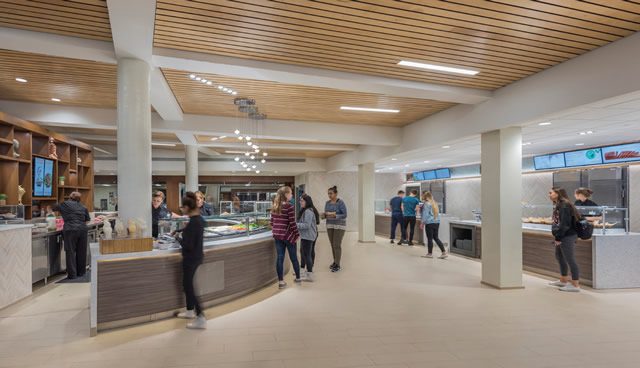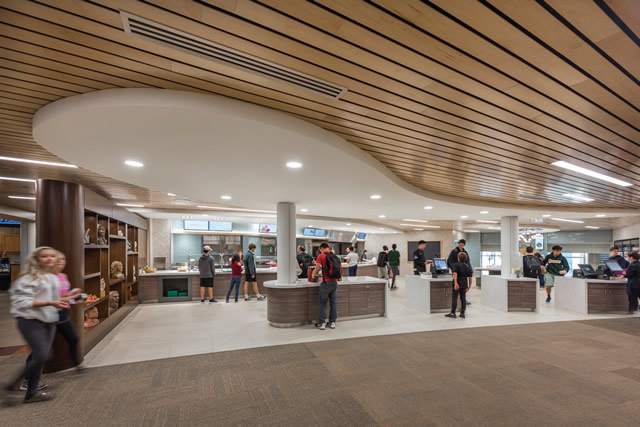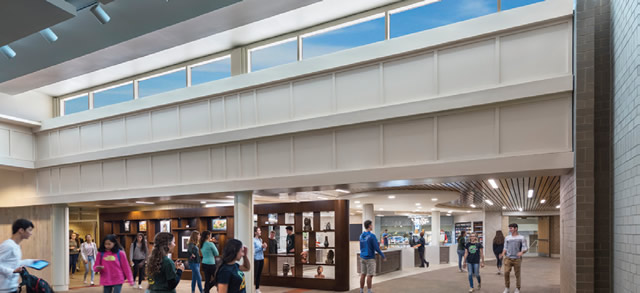Attracting Students to Healthier Food Choices Through Dining Design
- By Wendy Watts, Craig Siepka, Steve Shearer
- 03/01/20
While it may feel like students are often speaking a different language from other generations,
there’s one thing we all have in common — we eat with our
eyes first. So, it is imperative that in a nation where childhood
obesity has tripled since the 1970s, according to the National
Center for Biotechnology Information, and the number of
participants in the National School Lunch Program receiving
free or reduced lunch has risen from 15 percent in 1969 to 72
percent in 2016, students are presented with food options and
physical environments that encourage healthy eating.

Stevenson High School wanted to showcase its new dining hall with
improved LED lighting with recessed adjustable spot lights.
But as educators have discovered, healthy eating at school
isn’t just about changing the menu — it’s also about the
increasing significance of the student’s dining experience.
This is why more and more school systems are engaging firms
like ours to design and build dining facilities that motivate
students to opt for healthier school meals.
In fact, research shows that dining hall design upgrades
can yield a number of positive results for both schools and
students. Here are some examples to chew on:
Lessons from Starbucks and Chipotle
As part of its Facility Master Plan, Stevenson High School
in Lincolnshire, Ill., worked with us to reinvent its outdated
food service facility, which with its utilitarian finishes, overhead
florescent lighting, a drop ceiling and a layout that channeled
students through a single service line had a decidedly
“institutional” image. We responded with a forward-thinking
design that took its cue for lighting, display, signage and even
technology from popular retailers like Starbucks and Chipotle.
The new space was redesigned with upgraded finishes that
evoke a warmer, more restaurant-like feel. Large-scale porcelain
floor tile, wood veneer plank and baffle ceilings, a mix of glass
and Herringbone-patterned porcelain wall tile, a chalkboard
display wall, quartz countertops and laminate enclosures at the
food stations, and carpeted dining areas mimic what students
encounter when dining out.
Much in the way stores uses appealing lights to sell clothes,
Stevenson High School wanted to showcase its new dining
hall with improved LED lighting with recessed adjustable
spot lights, indirect up and down cover lights at the perimeter
to graze light partitions, glass pendant fixtures over select
food stations and recessed linear fixtures. We also used a color
rendering index measurement of (RA) greater than 90 in the
lighting and chose fixtures that accommodate directional aims
to highlight the food.
By creating separate food stations — including Homestyle,
International, Grill, Tossery, Hot and Cold bars — students can
move between options easier, which results in shorter lines. And
signage at these stations does more than just label what’s on the
menu. The use of fun infographics, photographs and even video
draws students to the healthier options at these stations.
This dynamic approach extends to food preparation, too. At
Chipotle, the kitchen makes food to spec. While school food
service facilities can’t go that far, they often can prep the food
to spec, engaging students in the action of the experience.
Another lesson from retail: put the goods you want to sell
at the front of the store. At Stevenson
High School, we brought the healthier
food stations, such as salads and
assortments of fruits, vegetables and
prepared protein options, up front
and positioned pizza, burgers and
fries deeper into the space.
All of these changes have yielded
clear results for Stevenson High
School. Purchases of less healthy
options decreased within one year after
the renovation: burgers were down by
5,200, and salads were up by 10,000.
Purchases of fries plummeted from
$144,000 to $50,000, and students
chose pizza 26 percent less often. Yet,
the average cost for lunch at the school
has increased only minimally, from
$2.90 to $3.21.

By creating separate food stations, students can move between
options easier, which results in shorter lines.
Catering to the On-Demand Generation
Today’s Gen Z students (middle schoolers and up) as well as
the emerging Alpha generation (currently in preschool and elementary
school) have grown up with instant gratification and
highly visual experiences thanks to early access to technology,
including mobile devices.
This also means they have never lived without an abundance
of on-demand choices. As such, engaging these students
to make healthy meal choices means offering as much
variety as possible, keeping lines short and, in the case of
some schools, providing access to food throughout the day. For
example, as part of our design-build food service project for
District 99 in Downers Grove, Ill., we are creating café-style
spaces at its two high schools, Downers Grove North and
South, that will serve students outside of the traditional lunch
period. This aligns with the design approach to the common
areas of a college student union.
And, as more schools take a page from universities and
adopt flexible eating schedules, these options will become more
relevant in school food service design. We also are currently
working with Main Township High School District 207 in Park
Ridge, Ill., to design upgrades that will create food service spaces
that best serve students with a partial block schedule.
In addition, with the move away from lunch-only food service,
some schools have begun offering after-school options for
students involved in sports, music programs and other extra-curricular
activities.
Fortunately for these
generations, schools aren’t
alone in encouraging
healthy eating. Parents
of Gen Z and Alphas are
more aware of the importance
of nutrition, and
they are raising their children
with an emphasis on
healthy, sustainable food.
For them, this goes beyond
asking schools to remove
soda and candy bars from
vending machines.
Adapting to these
students has also given rise to an interest on the part of some
schools to introduce food kiosks and mobile ordering. The day
when a student can place an order on an app and walk into the
lunchroom to pick up their food isn’t too far off. Standing in a
long line, pushing a tray along a counter past a limited assortment
of entrees and side dishes may soon be as anachronistic as
banging chalkboard erasers together to clean them.

The new space was redesigned with upgraded finishes
that evoke a warmer, more restaurant-like feel.
Supporting Socio-Emotional
Learning and Well-Being
Renovated and flexible, nutrition-focused food service and
dining spaces also have an impact on student’s socio-emotional
well-being. For example, in the case of open campuses, schools
that have appealing food offerings and settings see reduced trips
off campus for lunch, which in turn cuts down on potential
safety and time issues caused by students leaving school. Staying
on campus for lunch also gives students more time to access the
school resources they need, whether that’s an opportunity to
complete homework in school, meet with teachers or connect with
peers. Since opening its new dining hall, Stevenson High School
has seen the number of purchased lunches increase from 64
percent to 84 percent, indicating that fewer lunches are purchased
off campus.
Another by-product of better nutrition is better grades.
Healthier eating has been shown to raise student achievement
by four percentage points, according to California State
Department of Education and Economics at the University of
California.
These examples illustrate just some of the latest approaches
to food service design and why it’s so critical for schools to get
involved. Not only can changes like the ones mentioned above
have a positive impact on a student’s nutrition, but they can
also help future-proof schools in an environment where change
is quicker and more compelling than ever.
This article originally appeared in the March/April 2020 issue of Spaces4Learning.